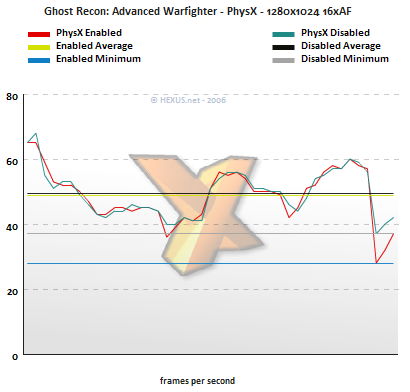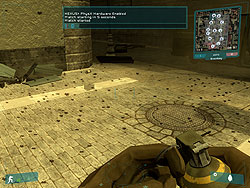Performance Data
We used the following platform to test performance of the BFG Tech PhysX accelerator:
|
|
|---|---|
| Processor(s) | AMD Athlon 64 FX-60 2.6GHz, dual-core, 1MiB L2 cache, Toledo |
| Mainboard(s) | DFI LanPartyUT nF4 SLI-D |
| Memory | 2GiB, 4 x 512MiB |
| Memory Timings | 2.0-2-2-5 @ 400MHz, 2T |
| BIOS Versions | 1103 |
| Disk Drive | 2 x 300GB Maxtor DiamondMax 10 SATA |
| Graphics Card(s) | NVIDIA GeForce 7800 GTX |
| Graphics Driver | NVIDIA ForceWare 84.25 |
| Physics Card(s) | BFG Tech PhysX |
| Physics Driver | AGEIA PhysX 2.4.2 |
| Operating System | Windows XP Professional, SP2, 32-bit |
[advert]
Game support just now is limited to Ghost Recon: Advanced Warfighter (my thanks to our .gaming editor Nick and Ubisoft for access to the full-game prior to release), Bet on Soldier (cheers again, Nick) and Rise of Nations (that I can tell from looking here), and even then GR:AW is pre-release at the time of writing.
I chose to use GR:AW (pre-release code) for our first look at what a PhysX board will get you performance wise in a current game, using that to explain how the hardware is likely to shape up in the first generation of supporting titles that will mostly use effect-based physics to tack on extra visual effects.
GR:AW Results
GR:AW is largely graphics limited at 1280x1024 -- our chosen test resolution -- so keep that in mind when you look at the following graph data.
You can see three pronounced dips in performance, corresponding each time to your author lobbing a grenade at a car and it being blown up. GR:AW uses the PhysX PPU to enable more bits of debris during explosions, enhancing their visuals.
There's a performance hit to be had for that effect when using the PPU, as you can see. It's a combination of data being generated for the PPU to work on (the cooking phase mentioned earlier), moved to the PhysX board, returned data when done, and then the extra visuals to be rendered by the game (largely just some alpha-blended sprites as I'll show you soon).
Depending on the game and what it uses the PPU for, there's PPU sim latency to be hidden and then any extra in-engine work to make use of the return data, be that visual or otherwise. More on that soon.
Click the following image to see the additional sprites that GR:AW draws when the PPU is used for the explosion effect, along with extra large chunks of debris.
The sprites are identical (if there's more than one variation I can't spot it, can you?) and just scaled, rotated and blended to give the illusion of randomness, and they don't persist, fading out after a short time.
While it's impressive the first few times you witness it, you soon spot the illusion and the smaller particles not persisting ruins the realism. Videos abound on the big wide interweb (Shrouty has a couple of good ones, here) of the GR:AW effects in action, using the PPU, if you want to see it moving (always the best way). It's OOH-worthy the first few times, but that's about it. In your author's opinion of course.
Bet on Soldier employs much the same tactic, using the PPU to enable visual effects. The PPU does work intermittently, but the large amount of game physics is still done on the CPU in both BoS and GR:AW.
If you think that such a limited analysis is a bit off, it's largely because there's simply not much to show you, or explain.
And therein lies the rub with this first wave of PhysX-enabled games. Let us explain.










